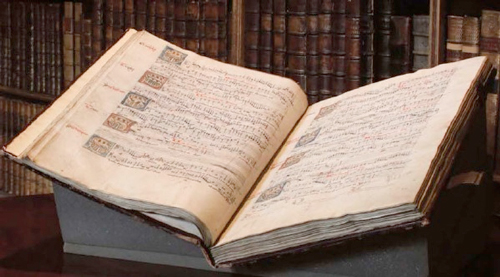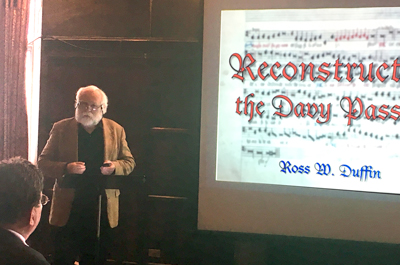by Daniel Hathaway

It’s still a mystery why so many pages of the late 15th-century Eton Choirbook that contains Richard Davy’s Matthew Passion went missing. But this weekend, Northeast Ohio audiences can hear Quire Cleveland sing the complete work in a restoration by its artistic director, Ross W. Duffin.
Performances will take place on Saturday, April 8 at 7:30 pm at St. Bernard’s Church in Akron, and twice on Palm Sunday, April 9 — at 3:00 pm at Historic St. Peter’s in downtown Cleveland, and at 7:00 pm (note corrected time) at St. Paul’s Episcopal Church in Cleveland Heights.
Davy, who was master of the choristers at Oxford’s Magdalen College in the early 1490s, wrote the first polyphonic setting of the Passion of Jesus we have by a known composer. Davy employed Sarum chant (named after Salisbury Cathedral) for the words of the Evangelist and Jesus, but set the words of the crowd and the other characters in four-voice polyphony. This weekend, guest soloists Owen McIntosh and Jeffrey Strauss will chant the words of the Evangelist and Jesus, and the 17 professional singers of Quire Cleveland will cover all the other roles.

He didn’t set himself an easy task. Of the 42 short polyphonic movements in the Passion, the first 11 are entirely missing, and the next 12 lack treble and tenor parts (the chant was sung from a separate book). Other editors had taken on the challenge before — Sir Richard Terry in 1921, and Frank Ll. Harrison in 1958 — but Terry’s is lost, and Duffin felt that the material Harrison used to replace missing pages (adapted from Davy’s later movements) lacked modal variety and suffered from mistakes in part-writing.

To involve modern audiences more deeply in the experience, Duffin has replaced the original Latin text with the English translation made by William Tyndale, Davy’s near-contemporary at Magdalen College. “It’s so vivid that I thought it could work in performance. I think it’s going to be entrancing for the audience,” Duffin said. “And unlike the Bach Passions, there are no arias or other insertions, which makes the narrative thread particularly strong.”

Published on ClevelandClassical.com April 3, 2017.
Click here for a printable copy of this article



